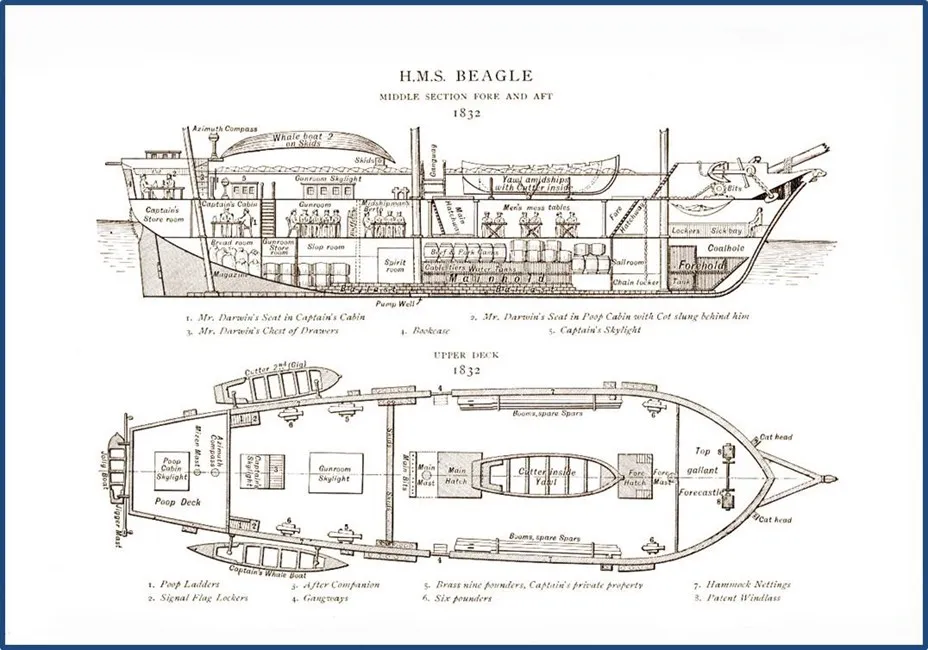The Final Home of Charles Darwin’s HMS Beagle Gets Protected Status
The naturalist famously conducted the research that led to the “Origin of Species” on board the ship
/https://tf-cmsv2-smithsonianmag-media.s3.amazonaws.com/filer/77/8e/778eb3c0-8757-44ac-bf94-e62e53f59a40/2020_may12_beagledock.jpg)
The HMS Beagle had many lives. It first launched on the River Thames on May 11, 1820, as a ten-gun brig in the Royal Navy, but was soon after converted into a research vessel. Most famously, the vessel played host to thefive-year journey on which Charles Darwin gathered the evidence that would lead to the theory of evolution.
In 1845, the ship was repurposed again into a customs service watch vessel, and after 25 years, it moored in the Paglesham mudflats in the town of Rochford, where the historic vessel was dismantled for scrap. Yesterday, in commemoration of the 200th anniversary of the Beagle's maiden voyage, the British government declared the recently discovered site of the ship's last days as a historic monument.
"We are glad to see this site in a quiet corner of Essex given national protection," Duncan Wilson, chief executive of Historic England, which recommended the site’s designation as a monument, says in a statement. "This is a fascinating example of a rare piece of maritime history."
The mud dock was uncovered last October by Wessex Archaeology, which spotted the outline of the structure using drone photography, the BBC reports. The site also has a brick slope, which would have been a stable walkway so people could walk along the side of the ship. Mud docks were probably common along major waterways, but only five have been recorded in England so far, per the Times’ Emma Yeomans.
Historic England suggests that parts of the Beagle might still remain in the mudflats, since previous archaeological surveys of the area have turned up evidence of ship debris. But for now, no further archaeological work is planned.
From 1831 to 1836, on its second of five scientific voyages, the Beagle circumnavigated the globe, focusing on surveying the shores of South America. The ship was refitted with a third mast and a collection of surveying instruments. Charles Darwin, only 22 years old at the start of the expedition, was invited along by his botany professor.

The ship was so packed with people and equipment, Darwin slept in a hammock strung above a drafting table. He gathered specimens of flora, fauna and fossils throughout the journey and had to cram the collection into a compartment at the front of the ship. With those specimens, Darwin meticulously developed his theory of evolution over the next two decades.
On the Origin of Species explained how a large population of any living thing has variations in it. Some of those variations are better at surviving in the environment they’re faced with, so they’ll end up passed to more offspring. Over a long time and many generations, the population will wind up with more of the trait that’s best for the task at hand. In the Galapagos, Darwin saw this pattern in finches that had beaks that matched the food available on their island home.
By the time Darwin published Origin, the Beagle’s days as a scientific vessel were long over. Its last research expedition, a survey of the Australian coast, ended in 1843, and it was sold to the customs service and renamed Watch Vessel No. 7. Its three masts were removed and the ship’s crew kept watch over the river system near the Paglesham mud flats, spotting smugglers along the Essex coast for 25 years. In 1870, the ship was sold for scrap at its dock in Rochford.
As a protected site, no changes can be made to the mud dock without the approval of the secretary of state, the Times reports. The local government plans to commemorate the Beagle with an observation platform that overlooks the area and to create a virtual tour of the ship as part of the year's bicentennial celebrations of the ship's first voyage.